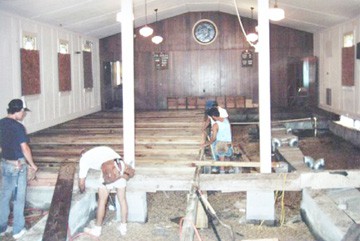Celebrating a Century of Faith and Fellowship
June 9, 1900, was a signal day in Chesapeake Country. The Chesapeake Beach Railway began bringing throngs of fun-seekers from Washington, D.C., to a new amusement park and sparkling beach resort at the mouth of Fishing Creek. A small community, incorporated in 1894 as the Town of Chesapeake Beach, had grown up around the park construction site. By 1900, development pushed toward the Anne Arundel County line as the land above Chesapeake Beach was platted for summer cottages. The developers called it North Chesapeake Beach.
By 1910, North Beach was incorporated. People bought lots and built cottages, and businesses appeared. However, places of worship were few. St. Anthony’s Parish, established in 1905, served the needs of Roman Catholics. But Protestant worshipers had far to go to find a church, traveling on rutted dirt and crushed oyster-shell roads. They could gather at Mount Harmony or Friendship Methodist churches, each four or five miles distant, accessible but hard to reach in that pre-automobile era.
So worshipers built a church that stands a century later.
During the first decade of the old century, the J.D. Timberlake family of Washington, D.C., built a comfortable summer home on Washington (now Chesapeake) Avenue in North Beach. In 1910, Mrs. Timberlake and Mrs. Appleton Cady began Sunday school classes for local children on the Timberlake front porch.
Adults came as well, and hymns were sung. On occasion, vacationing pastors or lay preachers preached sermons. From these beginnings, members of several Protestant denominations organized a church.
A lot was purchased and a building erected on Cleveland (now Frederick) Avenue in an undeveloped part of town. In July 1911, the interdenominational Church in the Woods began holding services. A large church bell, costing $14.80, was purchased to summon the faithful. A new $127 piano was added in 1912.
In less than a decade, the congregation outgrew the first small church.
An anonymous donor gave the church land on Washington Avenue, so the worshipers began a building fund of $1,000. Construction of larger quarters commenced in May 1921, and the new church opened in September 1922.
No longer tucked away in the woods, the congregation changed its name to Union Church of North Beach, reflecting its interdenominational character.
Through the 1920s, ministers from various denominations traveled to the beach on summer weekends to preach at Union Church. In 1931, the church called its first permanent pastor, the Rev. W.R. Frame, who served until 1935.
The middle decades of the century saw an increase of permanent residents at the Twin Beaches. In the late 1940s and 1950s, Union Church achieved the long-desired goal of a year-round ministry. Sunday school space grew, and a kitchen and indoor bathrooms were added.
Through the middle 1960s, pastors commuted from Washington. In 1965, the Rev. Charles McDaniel, fresh from Washington Bible College, became the first resident pastor. The congregation renovated a summer cottage behind the church into a parsonage for him annd his young family.
 |
Storms sometimes buffet the Twin Beaches, but Union Church has survived unscathed. The 1994 Valentine’s ice storm felled a large tree between the church’s two buildings, but neither structure was damaged. And while North Beach suffered greatly during Hurricane Isabel, the church lost only some shingles and siding.
Though much expanded, the original 100-year-old church remains the heart of the congregation overseen today by the Rev. Joe Engel. And the old Church in the Woods bell hangs in its tower, still ringing every Sunday morning.
When that old bell strikes this Sunday, July 17, at 11am, it will mark Union Church’s 100th anniversary. All are welcome. 8912 Chesapeake Avenue, North Beach.
